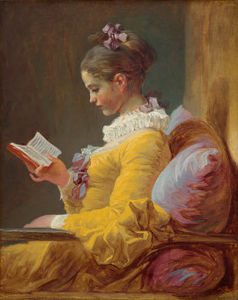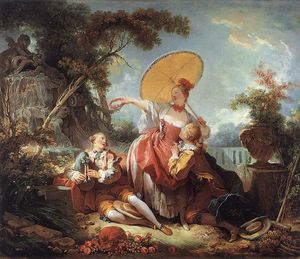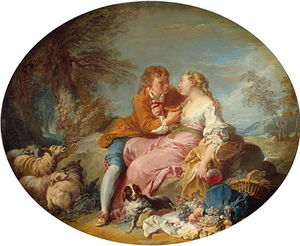Jean-Honore Fragonard
- Full Name:
- Jean-Honoré Nicolas Fragonard
- Short Name:
- Fragonard
- Date of Birth:
- 05 Apr 1732
- Date of Death:
- 22 Aug 1806
- Focus:
- Paintings, Drawings
- Mediums:
- Oil, Other
- Subjects:
- Figure, Scenery
- Art Movement:
- Rococo
- Hometown:
- Grasse, France
- Jean-Honore Fragonard Page's Content
- Introduction
- Artistic Context
- Biography
- Style and Technique
- Who or What Influenced
- Works
- Followers
- Critical Reception
- Bibliography
Introduction
As charming and witty as his paintings, Jean-Honoré Fragonard was one of the most prolific artists of his time, producing more than 550 works during his career.
Serving as an apprentice to Chardin and Boucher, two of the premier Rococo artists he won the Prix de Rome and attended the French Academy. Fragonard's work came with a high pedigree and prestige and as one of the last artists of the Rococo, his name is almost synonymous with this frivolous, erotic, and decadent movement.
Reputedly one of the most prolific painters of the 18th century, if not of all time, Fragonard had a feverish output of varied subject matter. From portraits to scenes of pastoral, erotic, or domestic appeal he covered a wide range of themes.
Fragonard's work is easily recognizable due to the lightness and frivolity of the subject matter, the deft touch of the brushwork, and the soft, carefree lighting schemes.
Jean-Honore Fragonard Artistic Context
Fragonard was a product of the later stages of the Rococo era, a time characterized by hedonistic freedom and a pursuit of all things aesthetically pleasing. The Rococo era originated from the French decorative style Racaille meaning 'decorative shell and rock work'.
It primarily stemmed from the architecture and furniture style that was popular amongst the bourgeois and new rising wealthy class in France who wanted works that reinforced their wealth and pleasure in all their beauty and splendor.
The Palace of Versailles was the ideal in decadent Rococo architecture, informed by ideas of the French Enlightenment, before the French Revolution came about.
A master of the domestic scene, the pastoral landscape and tongue-in-cheek eroticism of the boudoir painting, Fragonard had his share of admirers and wielded a strong influence over future masters of the art world, particularly the Impressionists.
Impressionism as a movement bears similarities to the Rococo in its emphasis on fleeting moments of beauty, sudden impressions, and pleasure.
Although for a time after the Revolution Fragonard disappeared from the history of art, his wittily airy style cropped up again years later with a new legion of imitators and by the end of the 19th century there was a rediscovery of Fragonard and other Rococo artists.
Jean-Honore Fragonard Biography
Early Years:
Jean-Honoré Fragonard led a full and charmed life. Moving from the South of France to Paris at a young age, his drawing skills were noticed by early employers as well as the Rococo painters Chardin and Boucher, both of whom he worked under as an apprentice.
After winning the Prix de Rome, Fragonard spent some years in Italy at the Royal Academy of Painting and Sculpture. Returning to Paris, he was admitted to the Royal Academy in 1765 and made a moderate name for himself with scenic paintings based on his Italian landscape drawings, created from idealized pastoral subject matter.
Intermediate Years:
Between the years of 1765-1770 Fragonard really made a name for himself amongst the aristocratic set, with his fanciful erotic portraits and lighthearted sexual scenes such as The Swing, possibly his most famous work.
Advanced Years:
Married in 1773, Fragonard's paintings focused more on domestic themes, particularly after the birth of his daughter Rosalie, who became one of his favorite models.
In the turbulent bloodbath of the French Revolution in 1789, Fragonard's major client base was wiped out under the merciless blade of the guillotine. He eventually moved back to Paris and died in relative obscurity in 1806 at the age of 74.
Jean-Honore Fragonard Style and Technique
Frivolous, colorful and gay, the works of Jean-Honoré Fragonard float into a spectator's sensory consciousness like pastel confections straight from a Parisian bakery on a spring day.
As one of the leaders of the Rococo movement, Fragonard's style of painting exemplifies all that was praised or criticized about this irreverent era, before the violent reform of the French Revolution.
Defining Characteristics:
Typical Subject Matter:
While Fragonard began his career in the Academy, he stuck to traditional subjects such as historical events or landscapes, with The Tivoli gardens proving particularly inspirational.
In later years he turned to the eroticism that would be his bread and butter with the decadent aristocracy. Exemplified in The Swing (see above), with its up-skirt action and overtly sexual ease of motion, Fragonard would pursue this theme for several years.
Though his subject matter tended to be rather erotic, his touch was light enough to keep the work from hitting a vulgar note.
After his marriage in 1769, Fragonard toned down the brazen sexuality of his earlier works to focus on scenes of domestic bliss, hearth, home and garden.
Figure Studies:
Clearly influenced by Rubens, Fragonard preferred a plump, healthy physique in his treatment of figures. When depicting aristocrats, a round figure was considered a sign of health and wealth.
Both Fragonard's men and women alike sported pale skin with rosy highlights, slender fingers and toes, and upswept messy hairdos that gave everyone the appearance of just rolling out of (if not still in) bed.
Fluid Brushwork:
The artist also seemed to take a cue from Rubens with his loose brushwork, reputedly being one of the swiftest painters that ever lived. By keeping the strokes fluid, Fragonard was able to capture the transient frivolity of the times, in which the political and social climate was constantly changing, along with the superficial fads and fashions of the era.
Candy-coated color Palette:
To match the lighthearted subject matter of Fragonard's compositions, the color palette is full of pastels; soft pinks, yellows and greens dominate both the figures themselves and the background, mostly wooded scenes.
Pastoral Lighting:
Particularly in Fragonard's outdoor scenes, he utilizes a soft, almost nostalgic lighting scheme that blurs the edges of the figures and softens the overall scheme. A silvery or golden tonality was often used, giving the picture an almost mythological air.
Who or What Influenced Jean-Honore Fragonard
A serious student of the masters, Fragonard combined classical study in France and Italy with love of the portraiture of the Dutch Baroque, and created his own style of lush, lighthearted eroticism that came to define the late Rococo.
Francois Boucher:
Fragonard worked directly under the tutelage of Francois Boucher, one of the forefathers of the Rococo and one of the premier decorative artists of the 18th century.
It's clear that from Boucher Fragonard learned his delicate use of color and sophisticated yet cheeky subject matter. Boucher managed to make even portraits or mythological scenes slightly erotic. The two artists shared patrons and were both favorites of the French court.
Peter Paul Rubens:
In the swift, almost frantic brushwork of Fragonard's paintings one can see the influence of the Baroque artist Rubens, who he greatly admired.
In addition, the rosy roundness of Fragonard's figures is distinctly Rubenesque. Along with this comes tranquility of tone and golden luminosity in lighting, both echoed in the works of Fragonard.
Frans Hals:
Frans Hals was one of the most prominent Dutch portrait painters and one of Fragonard's influences, particularly in terms of his portraits. In both artists you can see loose, whimsical brushstrokes, a light deftness of touch, and a lighthearted approach to realistic details.
Jean-Honore Fragonard Works
Jean-Honore Fragonard Followers
Fragonard had his share of admirers thanks to his mastery of the domestic scene, the pastoral landscape and tongue-in-cheek eroticism of the boudoir painting. He wielded a strong influence over future masters of the art world, particularly the Impressionists.
Jacques-Louis David:
Ridiculed during the time leading up to the Revolution by Enlightenment thinkers, post-Revolution Fragonard leaned more towards the Neoclassical ideals that would inform artists such as Jacques-Louis David.
One can see similarities in the clean lines of Fragonard's later work with the allegorical severity of David's, post-Revolution, though certainly David took his color palette and tone in a completely different and rather somber direction.
The Impressionists:
Though omitted from art history for a good half decade at least, by the end of the 19th century there was a rediscovery of Fragonard and other Rococo artists, who were a great influence on the new group of Impressionists.
Impressionism as a movement bears similarities to the Rococo in its emphasis on fleeting moments of beauty, sudden impressions, and pleasure.
Berthe Morisot:
Berthe Morisot was one of the most successful female French artists of the Impressionist movement, drawing her domestic subject matter from the later works of Fragonard, along with his use of soft, dappled light and delicate colors.
Edgar Degas:
Degas excelled in painting scenes of young girls, much like Fragonard. Obsessed mainly by young dancers, he captured his subjects in a soft light of youth and paid attention to the decadent swirls of costumes on a dance floor.
Pierre-Auguste Renoir:
Renoir, perhaps more than any of the other Impressionists, was compared to Fragonard in his subject matter which depicted the frivolity of his own era, from sunlit gardens, swings, and scenes of nightlife merriment.
Renoir always used bright warm colors and his paintings are infused with an air of immediacy of life, which is much the influence of the newly-respected Fragonard.
Jean-Honore Fragonard Critical Reception
Frothy and frivolous, the works of Jean-Honoré Fragonard not only served as a mirror of the pre-revolutionary era in Paris, but also stand nowadays as a time capsule of a brief-lived time period of decadence and seduction. While during his lifetime Fragonard was quite popular, his works, along with the rest of the Rococo, have fallen out of favor.
Contemporary Reception:
While Fragonard received no shortage of commissions from the aristocracy in Paris, the leading thinkers of the time had more unkind reactions to his work.
Paintings such as The Swing brought Fragonard harsh criticism from philosophers such as Denis Diderot, one of the foremost designers of the French Enlightenment. Diderot charged the artist with frivolity and suggested that he have "a little more self-respect. "
Rococo style fell under critical attack and by 1765 had entered its last phase. It was eventually replaced by the classical ideals and severity of Neoclassicism.
Posthumous Reception:
Post-revolution, there was no room for the shallow subject matter of the Rococo artists, Fragonard included. A great deal of his client base died during the Terror in Paris, and he was consequently forgotten for a while.
The style of his painting was forsaken in favor of cleaner lines, moral severity, and classical subject matter of the Neoclassicists.
Modern Day Reception:
Currently Fragonard is thought of as a relic of a time past, a testament to a somewhat innocent time period before the French Revolution wiped out the aristocracy and ushered in a new era of democracy.
The Rococo has not weathered the test of time too well as far as being heralded as an artistic period that produced anything of importance. Rococo artists lived in their own bubble, much like the noble class of the day, and now their work is regarded more out of historical interest rather than artistic.
Jean-Honore Fragonard Bibliography
For further information about Jean-Honoré Fragonard's contribution to the Rococo movement, please choose from the following recommended sources.
• Ashton, D. Fragonard in the Universe of Painting. Prentice Hall & IBD, 1988
• Cuzin, Jean-Pierre. Fragonard: Life and Work. Harry N. Abrams, Inc. , 1988
• Dupuy-Vachey, Marie-Anne. Fragonard. Pierre Terrail, 2006
• Molotiu, Andrei. Fragonard's Allegories of Love. J Paul Getty Trust Publications, 2008
• Massengale, Jean Montague. Fragonard (Masters of Art). Harry N. Abrams, Inc. , 1998
• Rosenberg, Pierre. Fragonard: Metropolitan Museum of Art. Harry N. Abrams, Inc. , 1988
• Rosenberg, Pierre. From Drawing to Painting: Poussin, Watteau, Fragonard, David, and Ingres (A. W. Mellon Lectures in the Fine Arts). Princeton University Press, 2000
• Sheriff, Mary D. Fragonard: Art and Eroticism. University of Chicago Press; 2nd edition, 1990

























